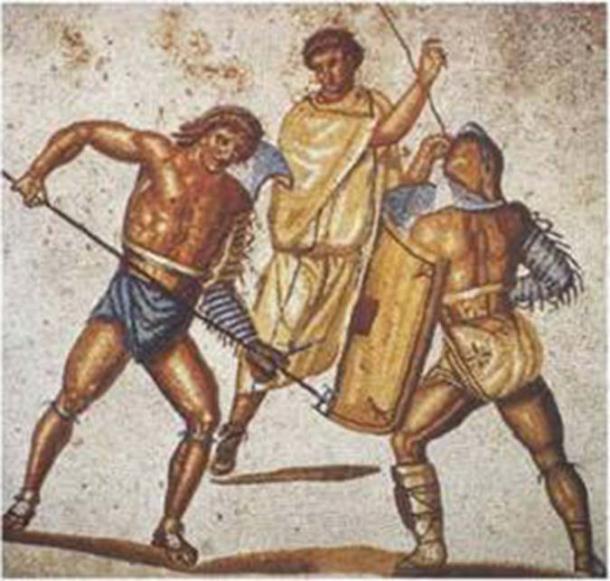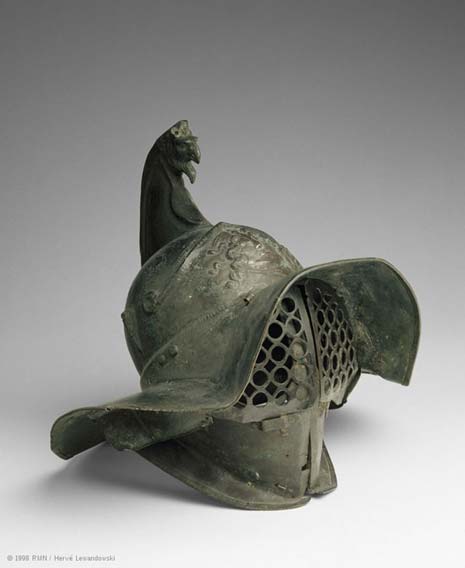
Gladiator Helmets: Fit for Purpose, Not Just Protection
The gladiator is most likely the first image one calls to mind when thinking about entertainment in ancient Rome. As most would already know, gladiators fought either each other or wild animals, in amphitheatres, such as the Colosseum in Rome, across the Roman world. There are various types of gladiators, each distinguished by the weapons and armor that were used. Thus, there were also a variety of gladiator helmets, which will be explored in this article.

A variety of gladiator types with their armor and weapons are shown on the Zliten mosaic. (Public Domain)
Who wore Gladiator Helmets?
One may begin with the fact that not all gladiators wore helmets. As an example, the retiarius (which may be literally translated to mean ‘net-man’ or ‘net-fighter’) is a type of gladiator that does not use a helmet. This gladiator is armed with a net, a trident, and a dagger. Compared to other gladiator types, the retiarius wore little armor, which consisted of an arm guard, a shoulder guard, and fabric padding. Thus, the retiarius relied on speed and agility in the arena. Needless to say, a heavy helmet would be a liability, and thus was not used by the retiarius. Another type of gladiator that did not use a helmet was the gladiatrix, or female gladiator. Battles involving gladiatrices were rare, and the lack of helmets was meant to emphasize their sex.
- The Real Lives of the Gladiators of Rome – The Unfathomable Sport of Life and Death
- The Gladiators of Rome: Blood Sport in the Ancient Empire

A retiarius gladiator stabs at his secutor opponent with his trident. Mosaic from the villa at Nennig, 2nd-3rd century AD (Public Domain)
The Secutor Helmet
The retiarius and the gladiatrices may be said to be the exceptions, rather than the norm, as most other types of gladiators were equipped with helmets. It may be added that the design of the helmets depended on the class of gladiator. For instance, the secutor (meaning ‘follower’ or ‘chaser’) was regularly pitted against the retiarius, and thus had a helmet devised specifically to protect him from the weapons of his opponent. The helmet of the secutor is shaped like the head of a fish, considering that its traditional opponent was meant to represent a fisherman. To maximise protection against the thrusting attacks of the retiarius’ trident, the secutor’s helmet was fitted only with two small eye-holes. The downside to this, however, was the visibility was limited. Additionally, the helmet had a rounded top, and lacked decorations, so as to prevent it from getting caught in the net of the retiarius.
- The legendary Spartacus: Gladiator and leader of slaves against the Romans – Part 1
- Did Ancient Warriors Really Go to Battle Wearing Winged Helmets?

Iron secutor style helmet from Herculaneum, 1st century. (CC BY-NC-SA-2.0)
Thracian Style Helmets
In contrast to the plain helmet of the secutor, some gladiator helmets had elaborate ornamentations. This may be seen, for instance, in the helmet of the Thraex (also known as Thracian). An example of this helmet is exhibited in the Louvre in Paris. This particular helmet was made of bronze and was unearthed in Pompeii. In terms of embellishments, this Thraex helmet has a crest decorated with plumes, and terminating in a griffin’s head. Additionally, there is a silver-plated head of Medusa on the front of the helmet. Plume holders are also present on either side of the helmet, which allowed feathers to be attached.
- Ancient Roman Tunnel from Gladiator Training School to Colosseum set to be Revived
- Animal-bitten, Wounded, and Decapitated—Who were these Roman-era Men Buried near York?

The helmet of a Thracian gladiator, the Louvre. (Image: © RMN, Musée du Louvre)
Murmillo Head Protection
It may be said that the design of the helmet used by the Thraex is quite similar to that worn by the murmillo, another type of gladiator. Both types of gladiators were heavily armed, and thus had a similar sort of helmet. The helmet of the murmillo, like that of the Thraex, had a broad brim, as well as a crest, which was adorned with plumes or horsehair. This crest would typically have a stylized fish on it, as the murmillo is sometimes referred to as the ‘fishman’. In contrast to the helmet of the secutor, those used by the thraex and the murmillo have ‘grill’ visors with multiple holes, which made breathing and seeing a bit easier.

Helmet of a murmillo (a type of gladiator during the Roman Imperial age), 2nd century AD, Neues Museum, Berlin. (CC BY-SA 2.0)
Last of all, some attention may be drawn to a rather curious type of gladiator called the andabata (which may be translated to mean ‘blindfolded gladiator’). This type of gladiator was referred to by Cicero in one of the letters to his friends. This type of gladiator is said to have fought on horseback - although this is questioned by some - and wore a type of helmet which had no eyeholes. In other words, such gladiators would be charging blindly at one another in the arena.
Top image: The helmet of a gladiator (reproduction). (Public Domain)
By Wu Mingren
References
Gill, N., 2017. Gladiator Types. [Online]
Available at: https://www.thoughtco.com/types-of-gladiators-118430
Historyextra, 2016. Gladiators in Ancient Rome: how did they live and die?. [Online]
Available at: https://www.historyextra.com/period/roman/gladiators-in-ancient-rome-how-did-they-live-and-die/
Klimczak, N., 2016. Gladiatrix: Female Fighters Offered Lewd Entertainment in Ancient Rome. [Online]
Available at: http://www.ancient-origins.net/history-ancient-traditions/gladiatrix-female-fighters-offered-lewd-entertainment-ancient-rome-005272
McCoss, F., 2015. The Real Lives of the Gladiators of Rome – The Unfathomable Sport of Life and Death. [Online]
Available at: http://www.ancient-origins.net/history/real-lives-gladiators-rome-unfathomable-sport-life-and-death-003512
Peterson, F., 2017. Top 10 Types Of Roman Gladiators. [Online]
Available at: https://listverse.com/2017/04/17/top-10-types-of-roman-gladiators/
The Louvre, 2018. Helmet of a Thracian Gladiator. [Online]
Available at: https://www.louvre.fr/en/oeuvre-notices/helmet-thracian-gladiator
United Nations of Roma Victrix (UNRV) , 2018. Roman Gladiator Types. [Online]
Available at: https://www.unrv.com/culture/roman-gladiators.php















